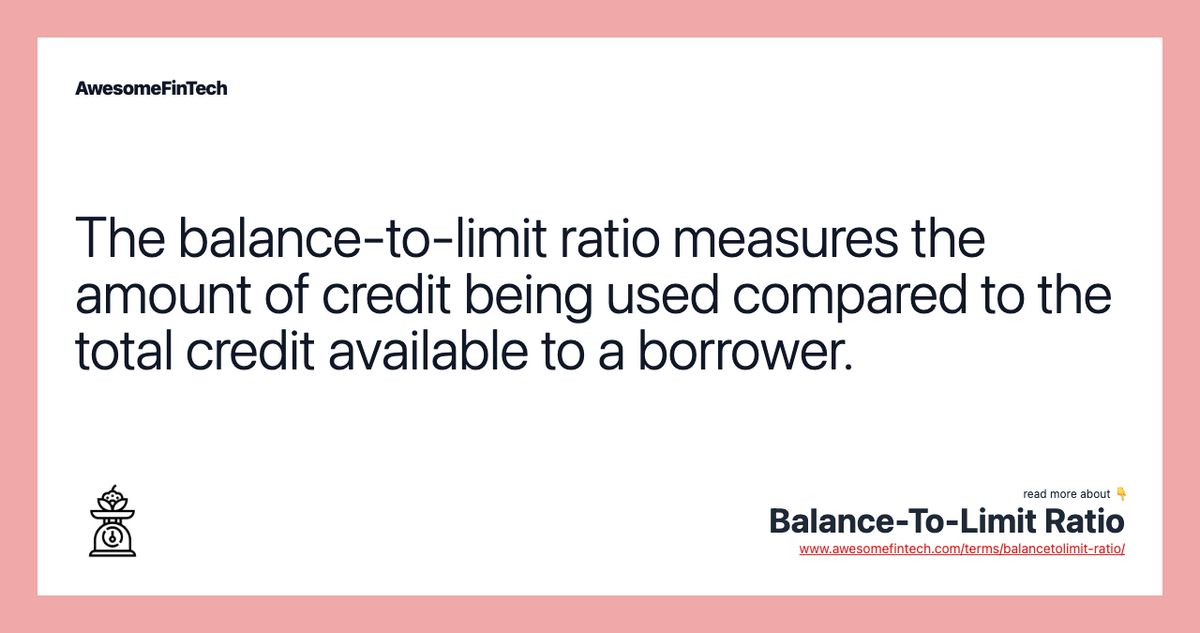What Is a Balance-To-Limit Ratio

What Is a Balance-To-Limit Ratio?
The balance-to-limit ratio is a comparison of credit used to total available credit. It tells lenders how much debt you are carrying compared to your available credit. It applies only to revolving debt, like credit cards.
The balance-to-limit ratio, also known as credit utilization ratio, is significant in calculating your credit score. A low ratio, both overall and on each card, can improve your credit score. Learn more about the ratio, its role in your credit score, and how to improve it.
Key Takeaways
-The ratio measures credit used compared to total credit available.
-It shows how carefully you manage your credit.
-A low ratio is preferable.
-More purchases increase the ratio.
-Paying down debt decreases the ratio.
How the Balance-To-Limit Ratio Works
The ratio shows how responsibly you manage credit and influences your credit score. A lower ratio indicates a lower risk borrower, making it better for your credit score.
Amounts owed count for 30% of your FICO credit score. If you plan to take out a loan, be aware of your ratio. You can check your overall debt by requesting a copy of your credit report from Experian, Equifax, or TransUnion. You are entitled to one free copy per year through AnnualCreditReport.com.
For credit scoring, it doesn’t matter whether you pay your balance in full each month or carry a balance. The key is to keep the ratio low on each card. Financial experts recommend keeping ratios below 30% for the best impact on your credit score.
Note
To improve your financial situation, keep the ratio low and pay credit card balances in full and on time each month. This prevents credit card interest and fees from eating into your available funds.
Role of Balance-to-Limit Ratios in Credit Scores
The ratio is an important part of your credit score. Higher scores make you a lower risk borrower, increasing your chances of loan approval and better loan terms. Lower scores make you a higher risk borrower, leading to loan denial or higher interest rates.
Note
Having a low ratio not only contributes to a healthy credit score but also saves you money by reducing interest payments.
How to Calculate Balance-to-Limit Ratios
For example, if you have one credit card with a $2,000 limit and a $200 balance, the ratio is 0.10 or 10% of your available credit.
If you have several credit cards, calculate the ratio by adding all balances and credit limits, then dividing the total balance by the total credit limit. For instance, if card A has a $300 balance and a $1,000 limit, card B has a $400 balance and a $2,000 limit, and card C has a $600 balance and a $3,000 limit, the ratio is 0.22 or 22% of your total credit.
How Is a Balance-to-Limit Ratio Different than a Debt-to-Income Ratio?
The ratio measures balance used compared to credit limit, while the debt-to-income ratio compares monthly debt payments to monthly income. Lenders consider both metrics when extending credit.
What Is a Good Balance-to-Income Ratio?
A good ratio is typically below 30%, but it depends on the lender’s criteria.
How Important is Your Balance-to-Limit Ratio?
Your ratio accounts for about 30% of your FICO credit score, making it a significant factor in determining your creditworthiness.
The Bottom Line
Your balance-to-limit ratio is a key factor in calculating your credit score. Lenders use it to assess your risk as a borrower and determine loan approval. To improve your ratio, keep your debt as low as possible and make more than the minimum monthly payment.



